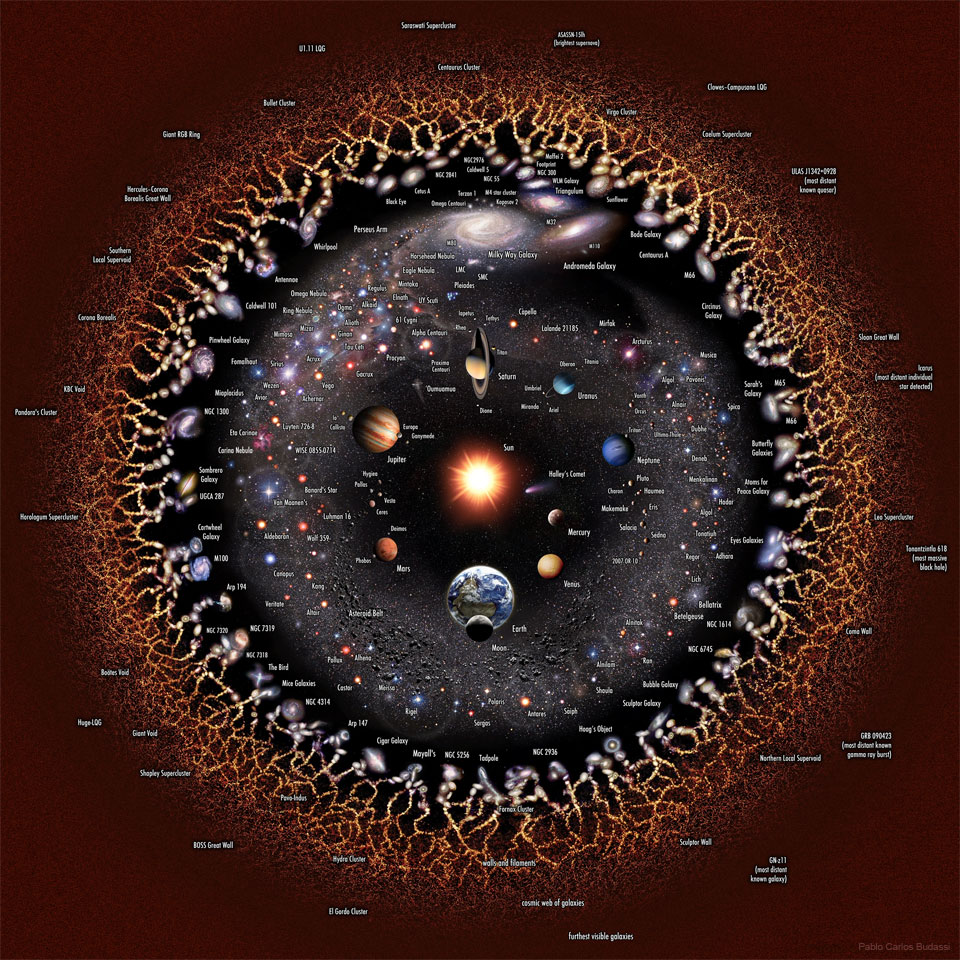16. March 2022
觀測會著 ê 宇宙

探索宇宙1!逐工會揀一幅無仝款 ê 影像抑是相片,𤆬你熟似咱這个迷人 ê 宇宙,閣有專業天文學者2為你3解說4。
- 原始文章:The Observable Universe
- 插圖提供 kah 許可:Wikipedia, Pablo Carlos Budassi
- 台文翻譯:An-Li Tsai (NCU)
[漢羅] 觀測會著 ê 宇宙
咱會當看偌遠? 咱先假設講,你 ê 目睭會當看著各種無仝款 ê 輻射光,按呢逐項你看--著 ê 抑是 可能看會著 ê 範圍,to̍h 是 觀測會著 ê 宇宙。 咱目前看會著上遠 ê 光是 宇宙微波背景,彼是 ùi 138 億年前 ê 宇宙來 ê。 彼當陣 ê 宇宙是無透光 ê,to̍h 親像是 厚-tut-tut ê 霧仝款。 有一寡仔 tī 咱邊仔 ê 微中子 kah 重力波,其實是 ùi 閣較遠 ê 所在來 ê。 毋閣人類 ê 技術猶未到,無法度量著 in。 這張相片 是用 愈來愈櫼 ê 尺度 來展示 觀測會著 ê 宇宙。 中央有 地球 kah 太陽,邊仔是 咱 ê 太陽系,閣來是 厝邊恆星、厝邊星系、遙遠星系、早期物質 ê 雲絲、kah 宇宙微波背景。 宇宙學家一般 ê 假設是講,咱這个 觀測會著 ê 宇宙,雖然干焦 leh 講咱附近 ê 宇宙爾爾,毋閣仝款 ê 物理概念,kah 規个「大宇宙」是相迵 ê。 毋閣,猶是有幾若个較流行、毋閣猶是推論 ê 講法 認為 講,咱 ê 宇宙 是 閣較大 ê 多層宇宙 ê 一部份。 這个多層宇宙,可能會有 無仝 ê 物理定數、無仝 ê 物理定律、較懸 ê 維度 leh 運作。 嘛有可能是以咱這个宇宙做標準,毋閣 閣小可仔無仝 ê 版本。
[POJ] Koan-chhek-ē-tio̍h ê Ú-tiū
Lán ē-tàng khòaⁿ gōa hn̄g? Lán seng ká-siat kóng, lí ê ba̍k-chiu ē-tàng khòaⁿ-tio̍h kok-chióng bô-kâng-khoán ê hok-siā-kng, án-ne ta̍k-hāng lí khòaⁿ--tio̍h ê iah-sī khó-lêng khòaⁿ-ē-tio̍h ê hoān-ûi, to̍h sī koan-chhek-ē-tio̍h ê ú-tiū. Lán bo̍k-chêng khòaⁿ-ē-tio̍h siōng hn̄g ê kng sī ú-tiū-bî-pho-pōe-kéng, he sī ùi 138 ek nî-chêng ê ú-tiū lâi ê. Hit-tang-chūn ê ú-tiū sī bô-thàu-kng ê, to̍h chhin-chhiūⁿ sī kāu-tut-tut ê bū kāng-khoán. Ū chi̍t-kóa-á tī lán piⁿ-á ê bî-tiōng-chú kah tiōng-le̍k-pho, kî-si̍t sī ùi koh-khah hn̄g ê só͘-chāi lâi ê. M̄-koh jîn-lūi ê ki-su̍t iáu bōe kàu, bô-hoat-tō͘ niû tio̍h in. Chit-tiuⁿ siòng-phìⁿ sī iōng lú-lâi lú-chiⁿ ê chhioh-tō͘ lâi tiān-sī koan-chhek-ē-tio̍h ê ú-tiū. Tiong-ng ū Tē-kiû kah Thài-iông, piⁿ-á sī lán ê Thài-iông-hē, koh-lâi sī chhù-piⁿ-hêng-chhiⁿ, chhù-piⁿ-seng-hē, iâu-oán-seng-hē, chá-kî bu̍t-chit ê hûn-si, kah ú-tiū-bî-pho-pōe-kéng. Ú-tiū ha̍k-ka it-poaⁿ ê ká-siat sī kóng, lán chit-ê koan-chhek-ē-tio̍h ê ú-tiū, sui-jiân kan-na leh kóng lán hū-kīn ê ú-tiū niā-niā, m̄-koh kāng-khoán ê bu̍t-lí khài-liām, kah kui-ê "Tōa-ú-tiū" sī sio-thàng ê. M̄-koh, iáu-sī ū kúi-ā-ê khah liû-hêng, m̄-koh iáu-sī thui-lūn ê kóng-hoat sī kóng, lán ê ú-tiū sī koh-khah tōa ê to-chân-ú-tiū ê chi̍t-pō͘-hūn. Chit-ê to-chân-ú-tiū, khó-lêng ē ū bô-kâng ê bu̍t-lí-tēng-sò͘, bô-kâng ê bu̍t-lí-tēng-lu̍t, khah koân ê ûi-tō͘ leh ūn-chok. Mā ū khó-lêng sī í lán chit-ê ú-tiū chò phiau-chún, m̄-koh koh sió-khóa-á bô-kâng ê pán-pún.
[KIP] Kuan-tshik-ē-tio̍h ê Ú-tiū
Lán ē-tàng khuànn guā hn̄g? Lán sing ká-siat kóng, lí ê ba̍k-tsiu ē-tàng khuànn-tio̍h kok-tsióng bô-kâng-khuán ê hok-siā-kng, án-ne ta̍k-hāng lí khuànn--tio̍h ê iah-sī khó-lîng khuànn-ē-tio̍h ê huān-uî, to̍h sī kuan-tshik-ē-tio̍h ê ú-tiū. Lán bo̍k-tsîng khuànn-ē-tio̍h siōng hn̄g ê kng sī ú-tiū-bî-pho-puē-kíng, he sī uì 138 ik nî-tsîng ê ú-tiū lâi ê. Hit-tang-tsūn ê ú-tiū sī bô-thàu-kng ê, to̍h tshin-tshiūnn sī kāu-tut-tut ê bū kāng-khuán. Ū tsi̍t-kuá-á tī lán pinn-á ê bî-tiōng-tsú kah tiōng-li̍k-pho, kî-si̍t sī uì koh-khah hn̄g ê sóo-tsāi lâi ê. M̄-koh jîn-luī ê ki-su̍t iáu buē kàu, bô-huat-tōo niû tio̍h in. Tsit-tiunn siòng-phìnn sī iōng lú-lâi lú-tsinn ê tshioh-tōo lâi tiān-sī kuan-tshik-ē-tio̍h ê ú-tiū. Tiong-ng ū Tē-kiû kah Thài-iông, pinn-á sī lán ê Thài-iông-hē, koh-lâi sī tshù-pinn-hîng-tshinn, tshù-pinn-sing-hē, iâu-uán-sing-hē, tsá-kî bu̍t-tsit ê hûn-si, kah ú-tiū-bî-pho-puē-kíng. Ú-tiū ha̍k-ka it-puann ê ká-siat sī kóng, lán tsit-ê kuan-tshik-ē-tio̍h ê ú-tiū, sui-jiân kan-na leh kóng lán hū-kīn ê ú-tiū niā-niā, m̄-koh kāng-khuán ê bu̍t-lí khài-liām, kah kui-ê "Tuā-ú-tiū" sī sio-thàng ê. M̄-koh, iáu-sī ū kuí-ā-ê khah liû-hîng, m̄-koh iáu-sī thui-lūn ê kóng-huat sī kóng, lán ê ú-tiū sī koh-khah tuā ê to-tsân-ú-tiū ê tsi̍t-pōo-hūn. Tsit-ê to-tsân-ú-tiū, khó-lîng ē ū bô-kâng ê bu̍t-lí-tīng-sòo, bô-kâng ê bu̍t-lí-tīng-lu̍t, khah kuân ê uî-tōo leh ūn-tsok. Mā ū khó-lîng sī í lán tsit-ê ú-tiū tsò phiau-tsún, m̄-koh koh sió-khuá-á bô-kâng ê pán-pún.
[English] The Observable Universe
How far can you see? Everything you can see, and everything you could possibly see, right now, assuming your eyes could detect all types of radiations around you -- is the observable universe. In light, the farthest we can see comes from the cosmic microwave background, a time 13.8 billion years ago when the universe was opaque like thick fog. Some neutrinos and gravitational waves that surround us come from even farther out, but humanity does not yet have the technology to detect them. The featured image illustrates the observable universe on an increasingly compact scale, with the Earth and Sun at the center surrounded by our Solar System, nearby stars, nearby galaxies, distant galaxies, filaments of early matter, and the cosmic microwave background. Cosmologists typically assume that our observable universe is just the nearby part of a greater entity known as "the universe" where the same physics applies. However, there are several lines of popular but speculative reasoning that assert that even our universe is part of a greater multiverse where either different physical constants occur, different physical laws apply, higher dimensions operate, or slightly different-by-chance versions of our standard universe exist.
詞彙學習
| 漢羅 | POJ | KIP | 華語 | English |
|---|---|---|---|---|
| 觀測會著的宇宙 | koan-chhek-ē-tio̍h ê ú-tiū | kuan-tshik-ē-tio̍h ê ú-tiū | 可觀測的宇宙 | observable universe |
| 輻射光 | hok-siā-kng | hok-siā-kng | 輻射 | radiations |
| 宇宙微波背景 | ú-tiū-bî-pho-pōe-kéng | ú-tiū-bî-pho-puē-kíng | 宇宙微波背景 | cosmic microwave background |
| 無透光 | bô-thàu-kng | bô-thàu-kng | 不透明 | opaque |
| 微中子 | bî-tiōng-chú | bî-tiōng-tsú | 微中子 | neutrinos |
| 重力波 | tiōng-le̍k-pho | tiōng-li̍k-pho | 重力波 | gravitational waves |
| 多層宇宙 | to-chân-ú-tiū | to-tsân-ú-tiū | 多層宇宙 | multiverse |
| 物理定數 | bu̍t-lí-tēng-sò͘ | bu̍t-lí-tīng-sòo | 物理常數 | physical constants |
| 物理定律 | bu̍t-lí-tēng-lu̍t | bu̍t-lí-tīng-lu̍t | 物理定律 | physical laws |
| 維度 | ûi-tō͘ | uî-tōo | 維度 | dimensions |
| 厝邊恆星 | chhù-piⁿ-hêng-chhiⁿ | tshù-pinn-hîng-tshinn | 鄰近恆星 | nearby stars |
| 厝邊星系 | chhù-piⁿ-seng-hē | tshù-pinn-sing-hē | 鄰近星系 | nearby galaxies |
| 遙遠星系 | iâu-oán-seng-hē | iâu-uán-sing-hē | 遙遠星系 | distant galaxies |
| 太陽系 | Thài-iông-hē | Thài-iông-hē | 太陽系 | solar system |